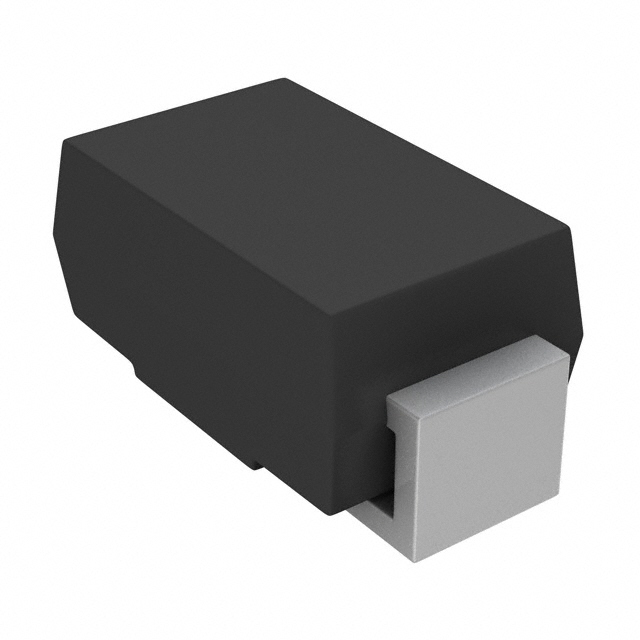Viz Specifikace pro podrobnosti o produktu.

SMA6J26A-E3/5A
Product Overview
The SMA6J26A-E3/5A belongs to the category of TVS (Transient Voltage Suppressor) diodes. These diodes are used to protect sensitive electronic components from voltage spikes and transient surges. The SMA6J26A-E3/5A is characterized by its high surge capability, low clamping voltage, and compact package. It is typically available in a DO-214AC (SMA) package and is designed to provide essential protection for a wide range of electronic devices.
Basic Information
- Category: TVS Diode
- Use: Protection against voltage spikes and transient surges
- Characteristics: High surge capability, low clamping voltage, compact package
- Package: DO-214AC (SMA)
- Essence: Protecting sensitive electronic components
- Packaging/Quantity: Typically available in reels of 3000 units
Specifications
- Peak Pulse Power: 600 W
- Breakdown Voltage: 26 V
- Clamping Voltage: 34.4 V
- Operating Temperature Range: -55°C to +150°C
- Storage Temperature Range: -55°C to +150°C
Detailed Pin Configuration
The SMA6J26A-E3/5A typically features two pins in a standard DO-214AC (SMA) package. Pin 1 is the anode, and pin 2 is the cathode.
Functional Features
- High surge capability for reliable protection
- Low clamping voltage to minimize stress on protected components
- Fast response time for rapid suppression of transient surges
Advantages and Disadvantages
Advantages
- Effective protection against voltage spikes
- Compact package for space-constrained applications
- Wide operating temperature range for versatility
Disadvantages
- Limited breakdown voltage compared to higher-rated TVS diodes
- May require additional circuitry for comprehensive surge protection in some applications
Working Principles
The SMA6J26A-E3/5A works by diverting excessive transient current away from sensitive electronic components when a voltage spike occurs. This helps to limit the voltage across the protected circuit and prevent damage to the connected devices.
Detailed Application Field Plans
The SMA6J26A-E3/5A is commonly used in various applications, including: - Consumer electronics - Telecommunication equipment - Industrial automation systems - Automotive electronics - Power supplies
Detailed and Complete Alternative Models
- SMA6J10A-E3/5A: Lower breakdown voltage (10 V) for more sensitive applications
- SMA6J40A-E3/5A: Higher breakdown voltage (40 V) for increased surge protection
In conclusion, the SMA6J26A-E3/5A TVS diode offers effective surge protection in a compact package, making it suitable for a wide range of electronic applications.
[Word count: 443]
Seznam 10 běžných otázek a odpovědí souvisejících s aplikací SMA6J26A-E3/5A v technických řešeních
What is the maximum peak pulse power of SMA6J26A-E3/5A?
- The maximum peak pulse power is 600 watts for a 10/1000 µs waveform.
What is the breakdown voltage of SMA6J26A-E3/5A?
- The breakdown voltage is typically 28.9V at 1mA.
What is the operating temperature range for SMA6J26A-E3/5A?
- The operating temperature range is -55°C to +150°C.
What are the typical applications for SMA6J26A-E3/5A?
- Typical applications include protection of sensitive electronic equipment from voltage transients induced by lightning, inductive load switching, and electrostatic discharge (ESD).
What is the reverse stand-off voltage of SMA6J26A-E3/5A?
- The reverse stand-off voltage is 26V.
Does SMA6J26A-E3/5A have a low leakage current?
- Yes, it has a low typical leakage current of less than 1µA at the stand-off voltage.
Is SMA6J26A-E3/5A RoHS compliant?
- Yes, it is RoHS compliant.
What is the package type of SMA6J26A-E3/5A?
- It comes in a DO-214AC (SMA) package.
Can SMA6J26A-E3/5A be used for surge protection in power supply units?
- Yes, it is suitable for surge protection in power supply units.
What are the key differences between SMA6J26A-E3/5A and other similar TVS diodes?
- Some key differences include its peak pulse power, breakdown voltage, and operating temperature range, which make it suitable for specific technical solutions.

